Effects of Different Ventilation Strategies on In-Cabin Air Quality During High-Speed Driving
Abstract
1. Introduction
2. Experimental Methods
2.1. Experimental Route
2.2. Experimental Sampling Points
3. Results and Discussion
4. Conclusions
- In the recirculation air mode, more outdoor air leaked into the cabin through gaps in the vehicle body at higher driving speeds. resulting in a lower in-cabin CO2 concentration.
- The use of the fresh air ventilation mode significantly reduced the in-cabin CO2 concentration, maintaining levels below 520 ppm at speeds above 40 km/h.
- While driving on highways, the ventilation system should be periodically switched between the recirculation air mode and the fresh air mode to maintain an in-cabin CO2 concentration lower than the ASHRAE [36] recommended limit of 1000 ppm.
- In the fresh air mode, the concentrations of PM2.5 and PM10 inside the cabin decreased with an increasing vehicle speed and approached the ambient concentrations.
- In the recirculation air mode, the cabin air filters effectively reduced the particulate concentration, resulting in lower in-cabin PM levels than those in the fresh air mode.
- The CO2, PM2.5, and PM10 concentrations exhibited linear relationships with the vehicle speed on a log-log scale. The fitted values of the CO2, PM2.5, and PM10 concentrations were in close agreement with the experimental measurements.
- Passenger vehicles are broadly categorized into three types: sedans, Sport Utility Vehicles (SUVs), and Multi-Purpose Vehicles (MPVs). While these differ in size and space, their HVAC systems share similar design principles. Therefore, similar conclusions should apply to different passenger vehicle models.
Author Contributions
Funding
Data Availability Statement
Conflicts of Interest
References
- WHO. Outdoor Air Pollution a Leading Environmental Cause of Cancer Deaths 17 October 2013. Available online: https://www.who.int/europe/news/item/17-10-2013-outdoor-air-pollution-a-leading-environmental-cause-of-cancer-deaths (accessed on 17 June 2024).
- Gu, K.Y.; Zhou, M.; Luo, W.; Liu, Y.; Dou, P.Y.; Huang, C.; Di, Q. Long-term exposure to fine particulate matter and cardiovascular disease: The mitigation role of environmental concerns. Sci. Total Environ. 2023, 875, 162656. [Google Scholar] [CrossRef]
- Lee, W.H.; Choo, J.Y.; Son, J.Y.; Kim, H. Association between long-termexposure to air pollutants and prevalence of cardiovascular disease in 108 South Korean communities in 2008–2010: A cross-sectional study. Sci. Total Environ. 2016, 565, 271–278. [Google Scholar] [CrossRef] [PubMed]
- Raaschou-Nielsen, O.; Beelen, R.; Wang, M.; Hoek, G.; Andersen, Z.J.; Hoffmann, B.; Stafoggia, M.; Samoli, E.; Weinmayr, G.; Dimakopoulou, K.; et al. Particulate matter air pollution components and risk for lung cancer. Environ. Int. 2016, 87, 66–73. [Google Scholar] [CrossRef]
- Cakmak, S.; Hebbern, C.; Pinault, L.; Lavigne, E.; Vanos, J.; Crouse, D.L.; Tjepkema, M. Associations between long-term PM2.5 and ozone exposure and mortality inthe Canadian Census Health and Environment Cohort (CANCHEC), by spatial synoptic classification zone. Environ. Int. 2018, 111, 200–211. [Google Scholar] [CrossRef]
- McGuinn, L.A.; Ward-Caviness, C.K.; Neas, L.M.; Schneider, A.; Diaz-Sanchez, D.; Cascio, W.E.; Kraus, E.W.; Hauser, E.; Dowdy, E.; Haynes, C.; et al. Association between satellite-based estimates of long-term PM2.5 exposure and coronary artery disease. Environ. Res. 2016, 145, 9–17. [Google Scholar] [CrossRef]
- Lanzinger, S.; Schneider, A.; Breitner, S.; Stafoggia, M.; Erzen, I.; Dostal, M.; Pastorkova, A.; Bastian, S.; Cyrys, J.; Zscheppang, A.; et al. Associations between ultrafine and fine particles and mortality in five central European cities—Results from the UFIREG study. Environ. Int. 2016, 88, 44–52. [Google Scholar] [CrossRef]
- Hassanvand, M.S.; Naddafi, K.; Faridi, S.; Nabizadeh, R.; Sowlat, M.H.; Momeniha, F.; Gholampour, A.; Arhami, M.; Kashanif, H.; Zareg, A.; et al. Characterization of PAHs and metals in indoor/outdoor PM10/PM2.5/PM1 in a retirement home and a school dormitory. Sci. Total Environ. 2015, 527–528, 100–110. [Google Scholar] [CrossRef]
- Barnett-Itzhaki, Z.; Levi, A. Effects of chronic exposure to ambient air pollutants on COVID-19 morbidity and mortality—A lesson from OECD countries. Environ. Res. 2021, 195, 110723. [Google Scholar] [CrossRef] [PubMed]
- Gall, E.T.; Chen, A.; Chang, V.W.C.; Nazaroff, W.W. Exposure to particulate matter and ozone of outdoor origin in Singapore. Build. Environ. 2015, 93, 3–13. [Google Scholar] [CrossRef]
- Choi, S.; Kim, E.M.; Kim, S.Y.; Choi, Y.; Choi, S.; Cho, N.; Park, H.J.; Kim, K.K. Particulate matter exposure exacerbates cellular damage by increasing stress granule formation in respiratory syncytial virus-infected human lung organoids. Environ. Pollut. 2022, 315, 120439. [Google Scholar] [CrossRef] [PubMed]
- Rasheed, H.; Jayasree, T.K. The multifaceted role of indoor plants: A comprehensive review of their impact on air quality health, and perception. Energy Build. 2025, 330, 115312. [Google Scholar] [CrossRef]
- Chen, X.C.; Ward, T.J.; Cao, J.J.; Lee, S.C.; Chow, J.C.; Lau, G.N.C.; Yim, S.H.L.; Ho, K.F. Determinants of personal exposure to fine particulate matter (PM2.5) in adult subjects in Hong Kong. Sci. Total Environ. 2018, 628–629, 1165–1177. [Google Scholar] [CrossRef] [PubMed]
- Kendrick, C.M.; Koonce, P.; George, L.A. Diurnal and seasonal variations of NO, NO2 and PM2.5 mass as a function of traffic volumes alongside an urban arteria. Atmos. Environ. 2015, 122, 133–141. [Google Scholar] [CrossRef]
- Prakash, J.; Choudhary, S.; Raliya, R.; Chadha, T.; Fang, J.X.; Biswas, P. PM sensors as an indicator of overall air quality: Pre-COVID and COVID periods. Atmos. Pollut. Res. 2022, 13, 101594. [Google Scholar] [CrossRef]
- Chuang, K.J.; Lin, L.Y.; Ho, K.F.; Su, C.T. Traffic-related PM2.5 exposure and its cardiovascular effects among healthy commuters in Taipei Taiwan. Atmos. Environ. 2020, 7, 100084. [Google Scholar] [CrossRef]
- Grange, S.K.; Fischer, A.; Zellweger, C.l.; Alastuey, A.; Querol, X.; Jaffrezo, J.L.; Weber, S.; Uzu, G.; Hueglin, C. Switzerland’s PM10 and PM2.5 environmental increments show the importance of non-exhaust emissions. Atmos. Environ. 2021, 12, 100145. [Google Scholar] [CrossRef]
- Beji, A.; Deboud, K.; Khard, S.; Muresan, B.; Flament, P.; Fourmentin, M.; Lumière, L. Non-exhaust particle emissions under various driving conditions: Implications for sustainable mobility. Environment 2020, 81, 102290. [Google Scholar] [CrossRef]
- Jeong, C.H.; Wang, J.M.; Hilker, N.; Debosz, J.; Sofowote, U.; Su, Y.S.; Noble, M.; Healy, R.M.; Munoz, T.; Dabek-Zlotorzynska, E.; et al. Temporal and spatial variability of traffic-related PM2.5 sources: Comparison of exhaust and non-exhaust emissions. Atmos. Environ. 2019, 198, 55–69. [Google Scholar] [CrossRef]
- Liu, Y.S.; Yi, L.; Xu, Y.; Cabison, J.; Eckel, S.P.; Chu, D.; Lurvey, N.; Lerner, D.; Johnston, J.; Bastain, T.M.; et al. Spatial and temporal determinants of particulate matter peak exposures during pregnancy and early postpartum. Environ. Adv. 2024, 17, 100557. [Google Scholar] [CrossRef]
- Kralla, J.R.; Adibah, N.; Babin, L.M.; Lee, Y.C.; Motti, V.G.; McCombs, M.; McWilliams, A.; Thornburg, J.; Pollack, A.Z. Estimating exposure to traffic-related PM2.5 for women commuters using vehicle and personal monitoring. Environ. Res. 2020, 187, 109644. [Google Scholar] [CrossRef] [PubMed]
- Branco, P.T.; Pinto, A.J.; Sousa, S.I. Characterising indoor air quality in private vehicle cabins under unprecedented traffic conditions during COVID-19 lockdown. Build. Environ. 2024, 262, 111797. [Google Scholar] [CrossRef]
- Beddows, D.C.S.; Harrison, R.M. PM10 and PM2.5 emission factors for non-exhaust particles from road vehicles: Dependence upon vehicle mass and implications for battery electric vehicles. Atmos. Environ. 2021, 244, 117886. [Google Scholar] [CrossRef]
- Chae, E.J.; Bae, S.H.; Lee, S.W.; Yun, J.H.; Choi, S.S.P.P. Characteristics of particulate matter from asphalt pavement and tire of a moving bus through driving tests in city road and proving ground. Environ. Pollut. 2024, 344, 123336. [Google Scholar] [CrossRef]
- Kim, N.G.; Jeong, S.B.; Jina, H.C.; Lee, J.W.; Kima, K.H.; Kima, S.; Park, Y.m.; Choi, W.S.; Kwak, K.H.; Lee, H.H.; et al. Spatial and PMF analysis of particle size distributions simultaneously measured at four locations at the roadside of highways. Sci. Total Environ. 2023, 893, 164892. [Google Scholar] [CrossRef] [PubMed]
- Matthaios, V.N.; Harrison, R.M.; Koutrakis, P.; Bloss, W.J. In-vehicle exposure to NO2 and PM2.5 A comprehensive assessment of controlling parameters and reduction strategies to minimise personal exposure. Sci. Total Environ. 2023, 900, 165537. [Google Scholar] [CrossRef]
- Lim, S.; Barratt, B.; Holliday, L.; Griffiths, L.J.; Mudway, I.S. Characterising professional drivers’ exposure to traffic-related air pollution: Evidence for reduction strategies from in-vehicle personal exposure monitoring. Environ. Int. 2021, 153, 106532. [Google Scholar] [CrossRef]
- Hasan Shahariar, G.M.; Sajjad, M.; Suara, K.A.; Jahirul, M.I.; Chu-Van, T.; Ristovski, Z.; Brown, R.J.; Bodisco, T.A. On-road CO2 and NOx emissions of a diesel vehicle in urban traffic. Transp. Res. Part D Transp. Environ. 2022, 107, 103326. [Google Scholar] [CrossRef]
- Chang, T.B.; Sheu, J.J.; Huang, J.W. Vehicle air leakage ventilation and its effect on cabin indoor air quality. Proc. Inst. Mech. Eng. Part E J. Process Mech. Eng. 2017, 231, 1226–1234. [Google Scholar] [CrossRef]
- Chang, T.B.; Hsu, Y.T.; Huang, J.h.W. Optimal ventilation strategies for balancing carbon dioxide and suspended particulate matter concentrations in vehicle cabins. Atmos. Environ. 2024, 334, 120697. [Google Scholar] [CrossRef]
- Chang, T.B.; Lin, Y.S.; Hsu, Y.T. CFD Simulations of Effects of Recirculation Mode and Fresh Air Mode on Vehicle Cabin Indoor Air Quality. Atmos. Environ. 2023, 293, 119473. [Google Scholar] [CrossRef]
- Chang, T.B.; Sheu, J.J.; Huang, J.W.; Lin, Y.S.; Chang, C.C. Development of a CFD model for simulating vehicle cabin indoor air quality. Transp. Res. Part D Transp. Environ. 2018, 62, 433–440. [Google Scholar] [CrossRef]
- Experimental Route Google Map. Available online: https://www.google.com/maps/dir/23.0474643,120.2525654/23.0214854,120.3255224/23.005986,120.2482406/23.0474634,120.2526039/@23.0140902,120.2018413,11z/data=!4m4!4m3!2m1!1b1!3e0?authuser=0&entry=ttu&g_ep=EgoyMDI1MDgxNy4wIKXMDSoASAFQAw%3D%3D (accessed on 19 August 2025).
- Telaire 7000 CO2 Sensor. Available online: https://www.amphenol-sensors.com/hubfs/Documents/AAS-920-315C-Telaire-T7000-Series-032614-web.pdf (accessed on 19 August 2025).
- BE-1190 Multi-Component Gas Analyzer. Available online: https://www.belltone.com.tw/Product/CatalogEng/BE-1190Eng.pdf (accessed on 19 August 2025).
- ANSI/ASHRAE Standard 62.1-2013; Ventilation for Acceptable Indoor Air Quality. ASHRAE: Atlanta, Georgia, 2013. Available online: https://ierga.com/wp-content/uploads/sites/2/2017/10/ASHRAE-62.1-2013.pdf (accessed on 17 June 2024).
- Yang, W.C.; Wang, J.; Deng, E.; Liu, Y.K.; Luo, L.S.; Yang, J. A hybrid ventilation scheme applied to bidirectional excavation tunnel construction with a long inclined shaft. J. Cent. South Univ. 2024, 31, 3187–3205. [Google Scholar] [CrossRef]
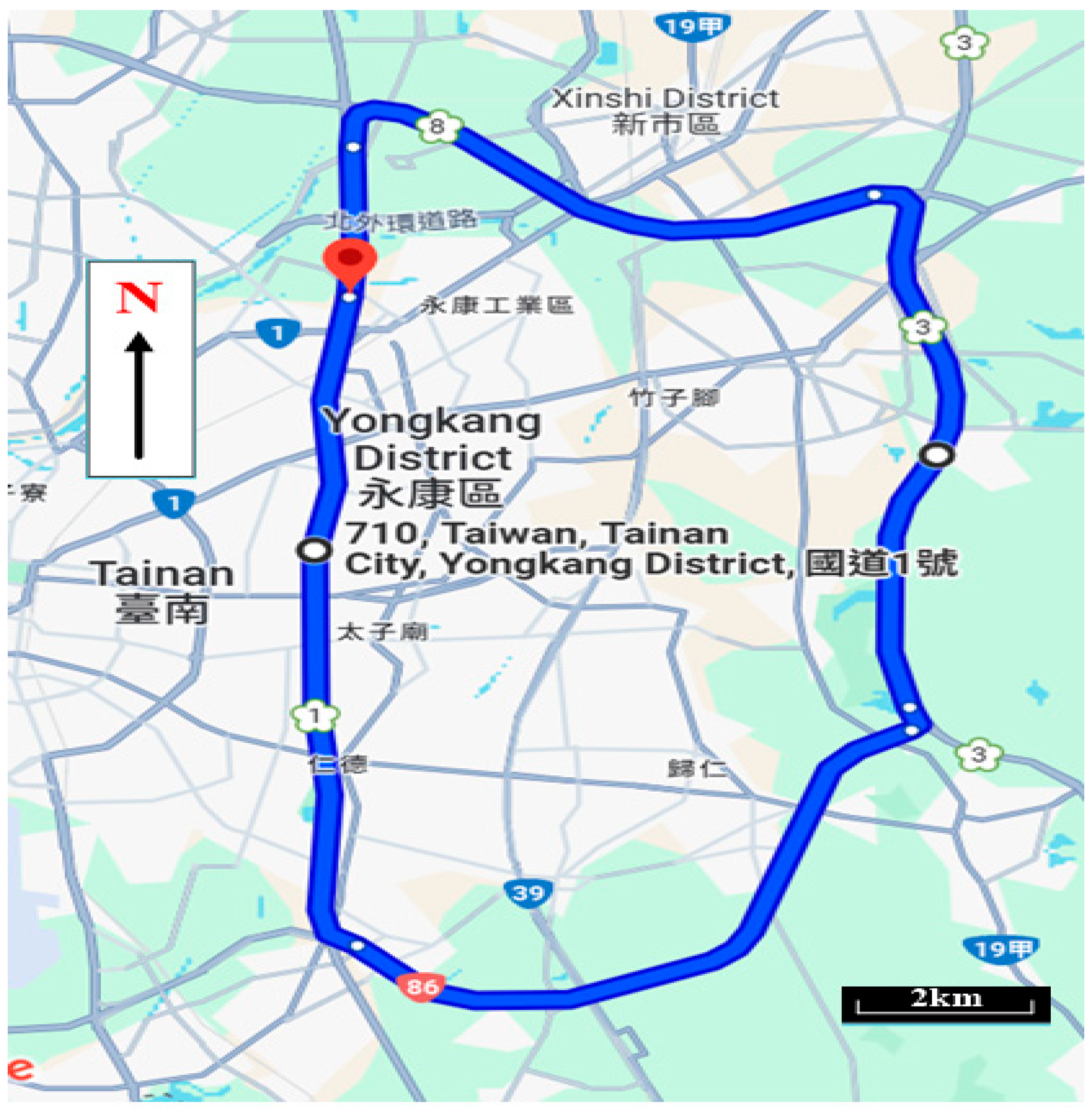

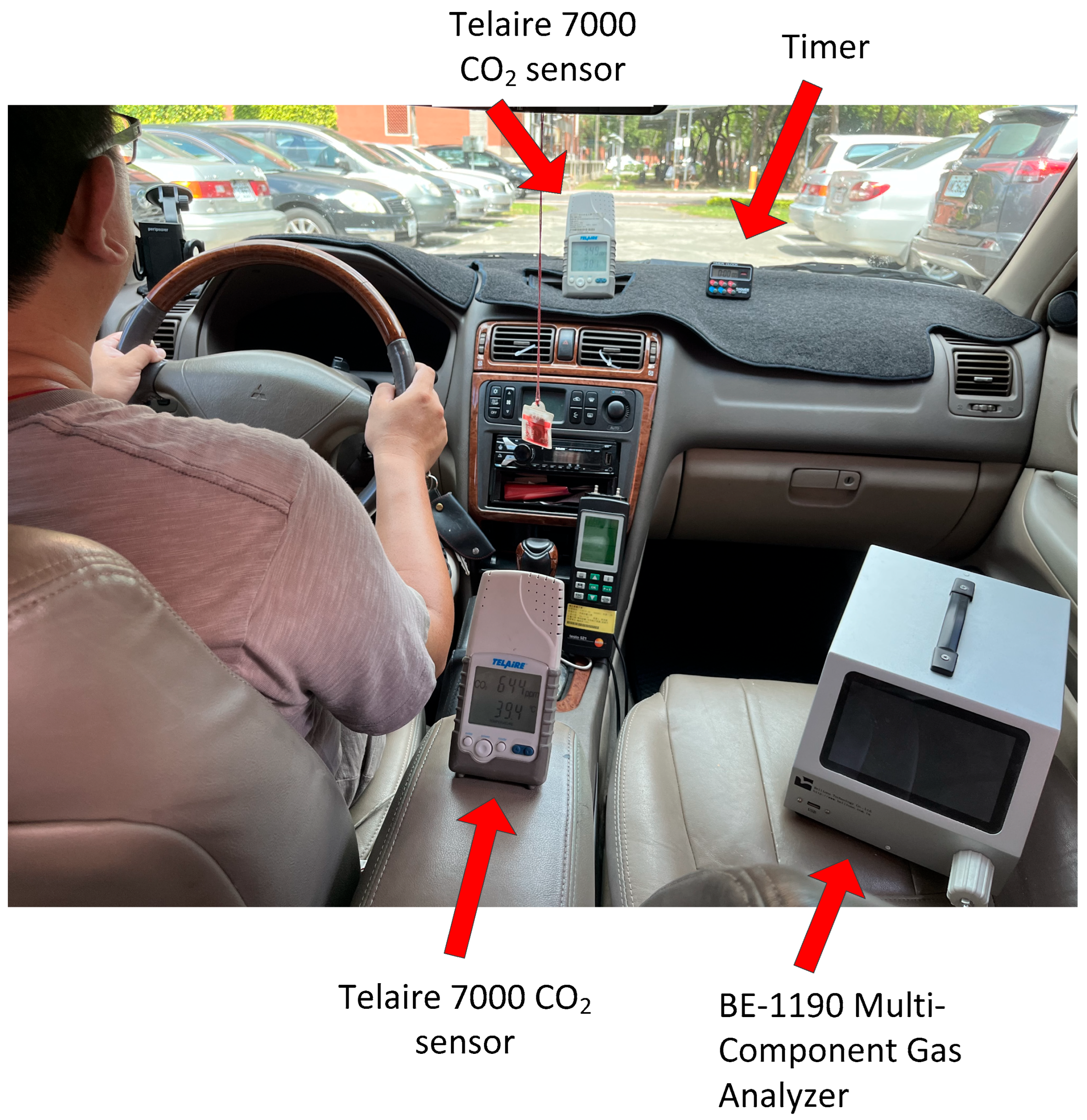
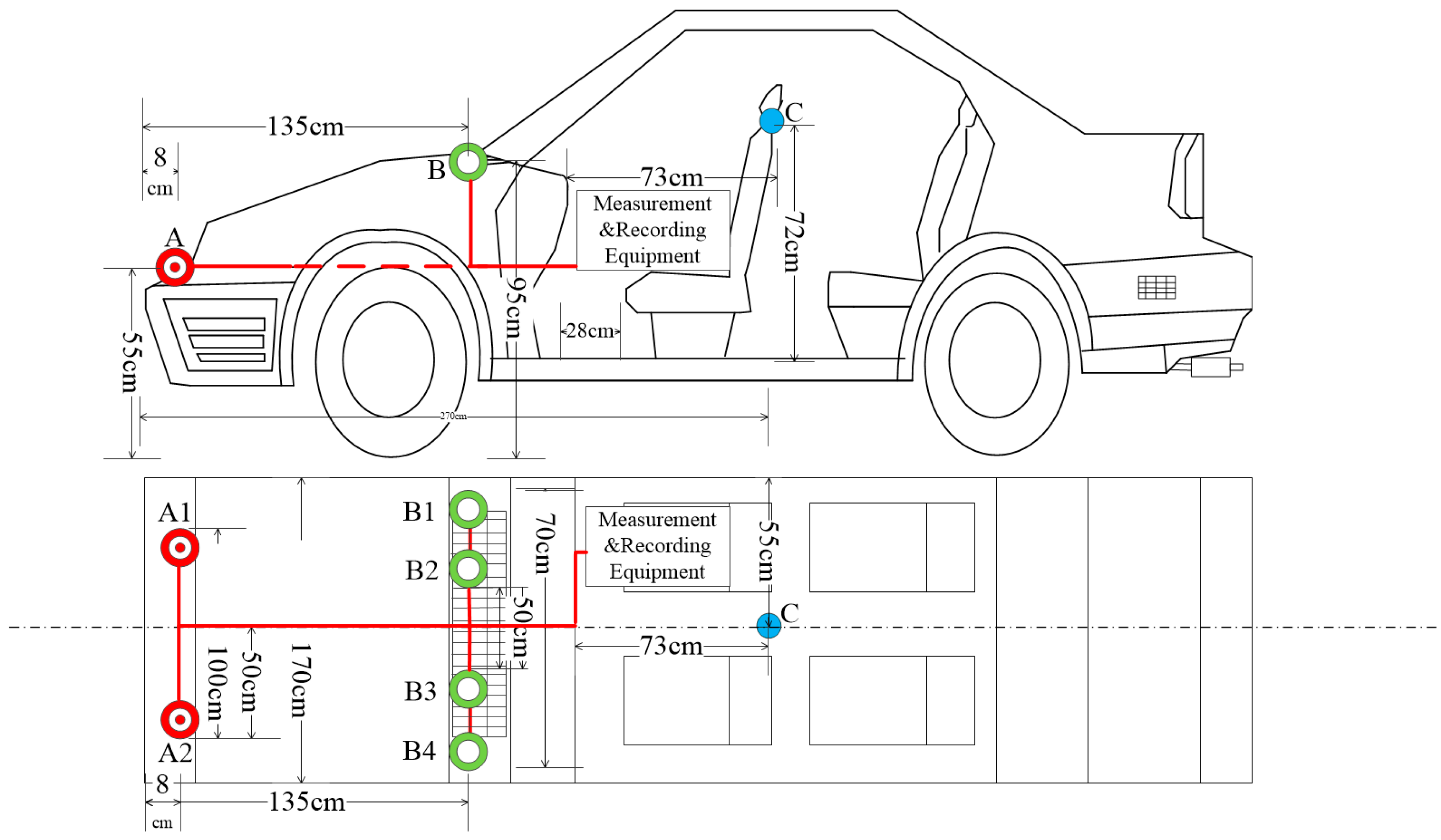


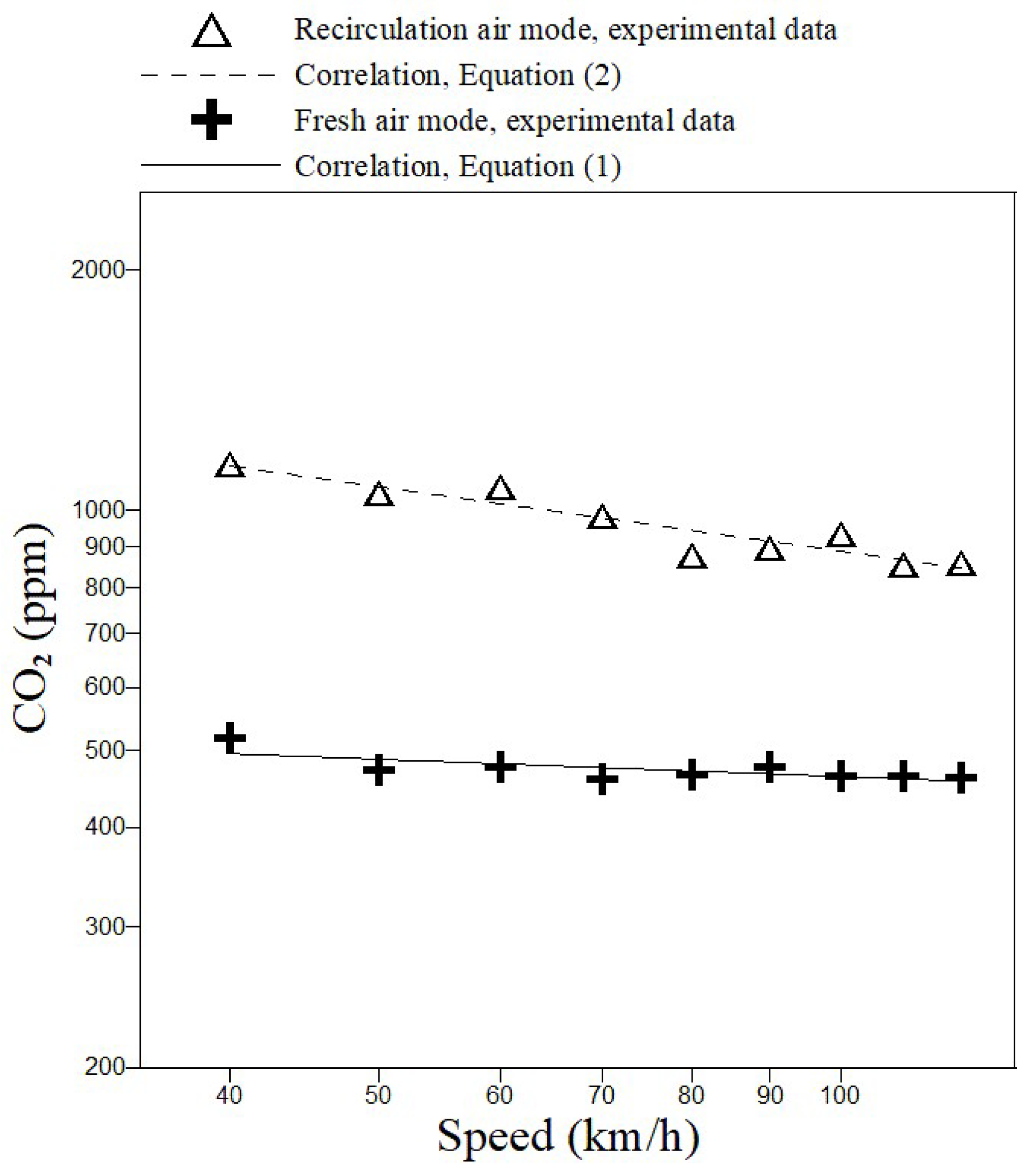
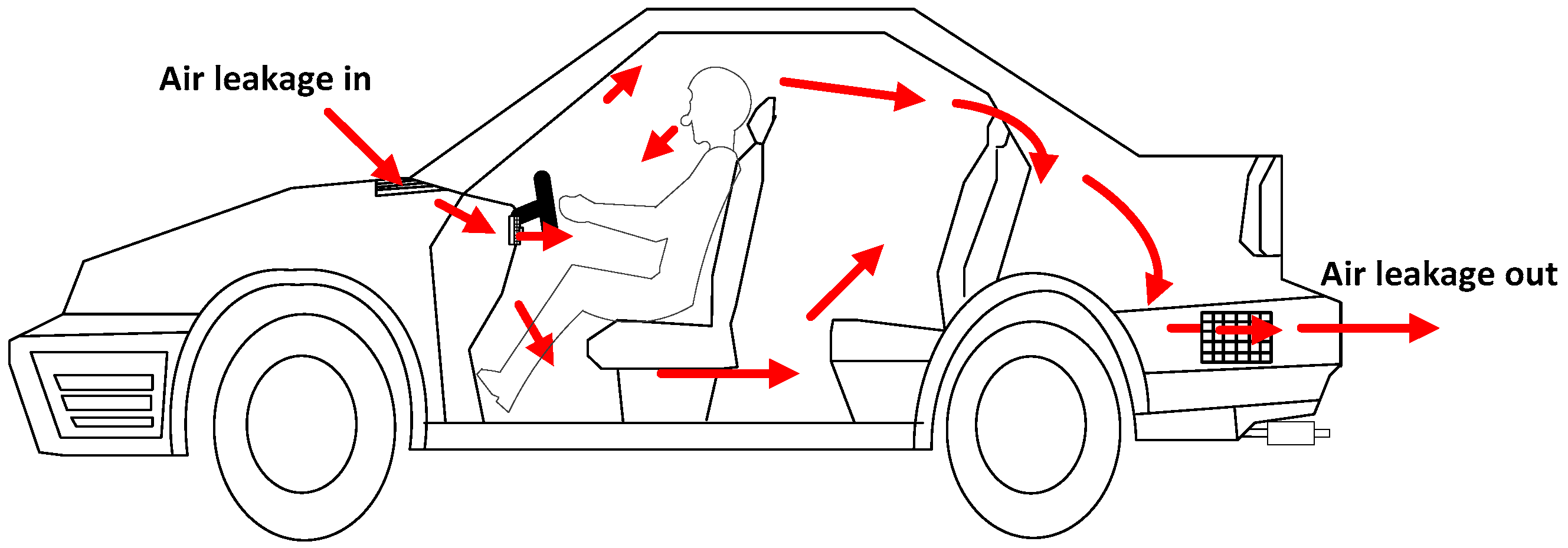
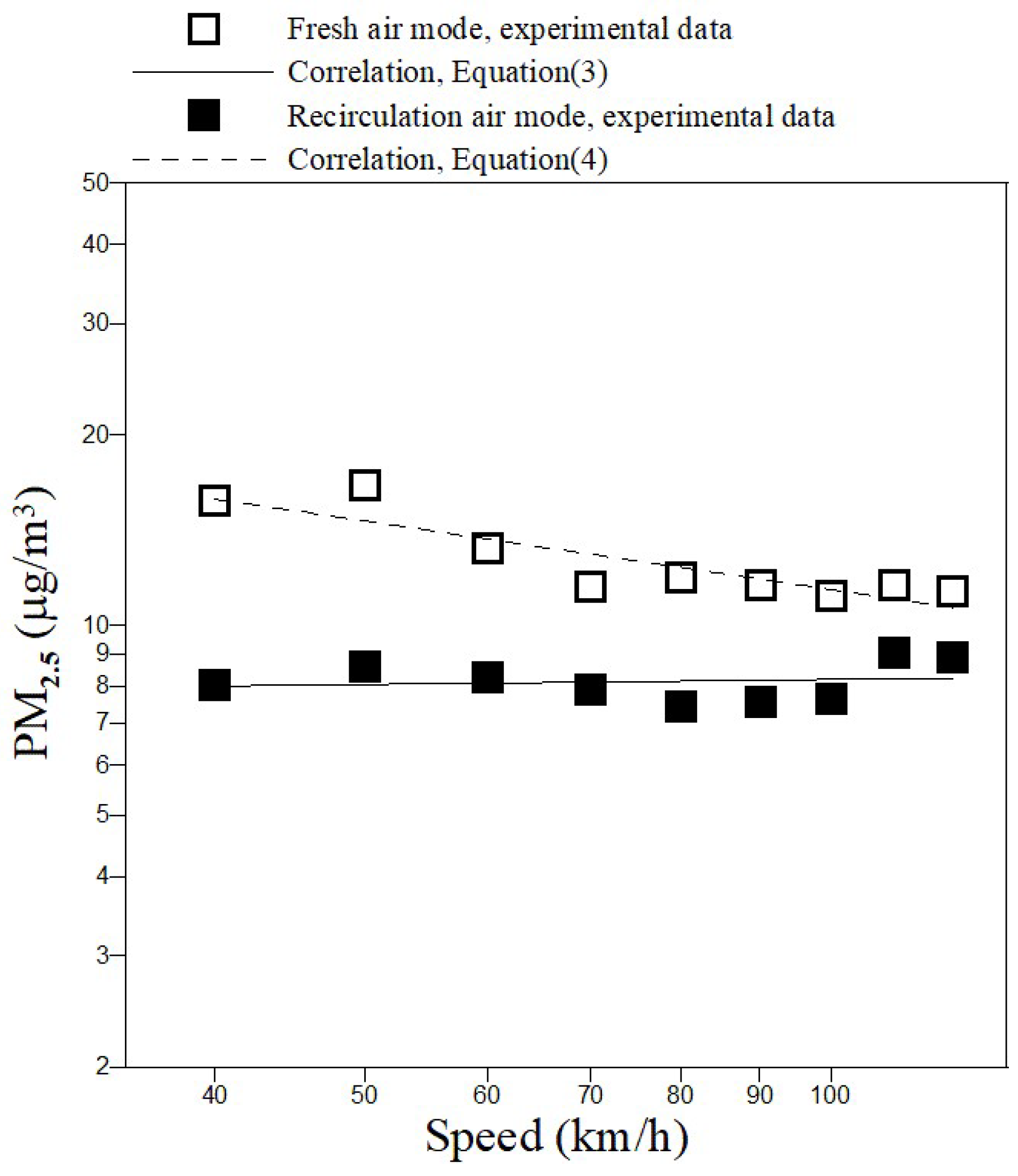

| Segment | National Highway No. 1 | National Highway No. 8 | National Highway No. 3 | Expressway No. 86 | |
|---|---|---|---|---|---|
| Speed | |||||
| 60 (km/h) | 14–16 (min) | 8–10 (min) | 10–12 (min) | 10–12 (min) | |
| 70 (km/h) | 12–14 (min) | 7–9 (min) | 8–10 (min) | 9–11 (min) | |
| 80 (km/h) | 10–12 (min) | 6–8 (min) | 7–9 (min) | 8–9 (min) | |
| 90 (km/h) | 9–11 (min) | 5–7 (min) | 6–8 (min) | 7–8 (min) | |
| 100 (km/h) | 8–10 (min) | 5–6 (min) | 6–7 (min) | 6–8 (min) | |
| 110 (km/h) | 7–9 (min) | 4–6 (min) | 5–7 (min) | 5–7 (min) | |
| 120 (km/h) | 7–8 (min) | 4–5 (min) | 5–6 (min) | 5–6 (min) | |
Disclaimer/Publisher’s Note: The statements, opinions and data contained in all publications are solely those of the individual author(s) and contributor(s) and not of MDPI and/or the editor(s). MDPI and/or the editor(s) disclaim responsibility for any injury to people or property resulting from any ideas, methods, instructions or products referred to in the content. |
© 2025 by the authors. Licensee MDPI, Basel, Switzerland. This article is an open access article distributed under the terms and conditions of the Creative Commons Attribution (CC BY) license (https://creativecommons.org/licenses/by/4.0/).
Share and Cite
Chang, T.-B.; Huang, J.-W. Effects of Different Ventilation Strategies on In-Cabin Air Quality During High-Speed Driving. Pollutants 2025, 5, 36. https://doi.org/10.3390/pollutants5040036
Chang T-B, Huang J-W. Effects of Different Ventilation Strategies on In-Cabin Air Quality During High-Speed Driving. Pollutants. 2025; 5(4):36. https://doi.org/10.3390/pollutants5040036
Chicago/Turabian StyleChang, Tong-Bou, and Jhong-Wei Huang. 2025. "Effects of Different Ventilation Strategies on In-Cabin Air Quality During High-Speed Driving" Pollutants 5, no. 4: 36. https://doi.org/10.3390/pollutants5040036
APA StyleChang, T.-B., & Huang, J.-W. (2025). Effects of Different Ventilation Strategies on In-Cabin Air Quality During High-Speed Driving. Pollutants, 5(4), 36. https://doi.org/10.3390/pollutants5040036







